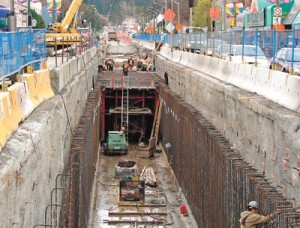Curbed LA writes about a partial court victory for downtown LA businesses that object to the “cut-and-cover” tunneling method in LA’s new regional connector light rail line. The line will travel through downtown LA, providing a badly needed link between the light rail lines ending at Union Station and beginning at the Blue/Expo Line stations not far from Staples Center in downtown. Right now, riders need to transfer to the heavy rail Red Line to connect, which adds a lot of time and hassle given the layout of Union Station.
Cut-and-cover is the cheapest way to tunnel: builders basically dig a trench in the road and then cover it with temporary decking to allow cars to drive above. They lay the rail tracks in the trench and then permanently pave the roof. The alternative is expensive and slow tunnel boring machines, which don’t disrupt above-ground activity (except where the machines enter and exit the earth) but add huge costs. Readers of Doug Most’s book on the New York and Boston subways will remember that cut-and-cover was the method used in both cities (with the exception of one part of the New York line). It partly explains why it was so much cheaper to build those systems, even adjusted for today’s dollars, than LA’s subway project, with its tunnel boring machines.But New York and Boston’s experiences also point to the political drawback of “cut-and-cover”: businesses on the ground hate it. It’s tremendously disruptive. In Boston, those businesses were politically weak, and their objections were overruled. The trenching was disruptive, but construction finished quickly and relatively inexpensively, with long-term gain. In New York, by contrast, the downtown businesses were powerful and ultimately successful, forcing a rerouting of the subway. But it got done with cut-and-cover.
Given the high cost of tunnel boring machines, I’d love to see transit agencies like Metro get the courage to go for cut-and-cover over the objections of local businesses. The savings for taxpayers are enormous, and perhaps some of those savings can be used to compensate the local businesses for any economic losses. And of course, the trenching should be done with the least disruption for those businesses as possible.
Based on the write-up of this decision, it sounds like Metro won’t have too much trouble justifying its cut-and-cover decision and complying with the court order. But the lawsuit points to the political challenges of trying to save money on rail lines. Powerful opponents and can force expensive changes that cost these lines political support. Ultimately, these political construction decisions deprive the rest of the city of the funds needed to build and maintain other needed transit lines.
Leave a Reply
You must be logged in to post a comment.



